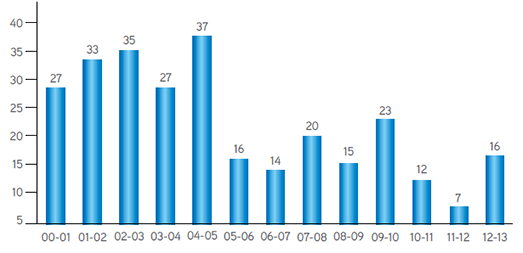Social Performance
 Occupational Health And Safety
Occupational Health And Safety
ITC gives special emphasis to the Occupational Health & Safety interests of its employees (including that of service providers) and all visitors to its establishments. This is ensured through adherence to Corporate Environment, Health & Safety Guidelines, which incorporates best international standards and practices. Corporate resources and expert third party agencies audit all ITC establishments on a periodic basis in order to verify compliance. The EHS performence of all ITC Units is reviewed periodically at the Corporate Management Committee level.
Towards Zero Accident
ITC’s Paperboards and Specialty Papers Business Unit at Bhadrachalam, the country’s largest integrated pulp and paper mill, faces specific challenges due to scale and growth of business. Despite this fact, the on-site injury rate (own employees) for Bhadrachalam has come down from 0.07 in 2011-12 to 0.04 in 2012-13. In addition to the effective implementation of engineering controls, the recently initiated behaviour safety programme has significantly contributed in achieving this performance
All our factories, hotels and large offices have established Environment, Health & Safety (EHS) Management systems with designated roles and responsibilities, competent EHS resources and safety infrastructure, which are continuously upgraded to achieve compliance with best international standards. In addition, strong employee involvement is encouraged through participation in suggestion schemes, celebration of EHS events etc.
The process of risk assessment has been institutionalised across Businesses wherein risks are systematically identified and mitigation plans implemented. All new projects and major renovation jobs are reviewed and vetted at the design stage by Corporate EHS experts and engineering control measures are implemented at the project stage itself. Pre commissioning audits are also conducted to ensure compliance with all EHS requirements.
A comprehensive incident/accident reporting system has been established in all Units. These incidents/accidents undergo a thorough investigation for identifying root causes and accordingly, corrective/ preventive measures are initiated. The findings and recommendations are also discussed in the Safety Committee meetings to ensure complete management and employee buy in. In order to disseminate the learnings from accidents, details of serious accidents, along with the root cause analysis and proposed corrective measures are communicated across the Company. This enables Units to take proactive action in eliminating/controlling similar situations.
Based on the root-cause analyses of accidents over the years, the approach to safety has been redefined with the focus now on fostering a culture of safety and use of behavioural architecture techniques. This is being enabled by the creation of an organisation wide culture of safety, involving individual ownership and integrating with business processes which also support a “One Unit-One team” approach. Such a shared ownership not only ensures accountability but also provides the opportunity for optimisation in safety hardware costs.
The safety management system is being tuned to ensure that training and other communications are relevant and that local socio-economic context are factored in to make the transition from “awareness developed” to “changed behaviour”. This approach which combines empowerment and ownership with targeted interventions and strict accountability should help us in achieving our goal of “Zero Accidents”.
On-Site Safety Performance
In ITC, Lost Time Accident (LTA) is defined as an accident where the injured is not able to come back to work for the next scheduled shift. This definition is more stringent than the ‘Reportable Accident’ as per the Factories Act, 1948, which is defined as an accident where an injured person is unable to resume duty within 48 hours after the accident.
Lost Time Accidents (LTA)

In 2012-13, the number of on-site Lost Time Accidents (LTA) of own employees was 16 (against 7 in 2011-2012), as detailed above. Detailed investigation and analyses of accidents helped us better understand the challenges being faced by our new business units presently under the process of stabilisation. As mentioned earlier, besides the strong engineering approach, safety culture programmes are being institutionalised and behavioural architecture inputs are being used to rework and recalibrate our approach.
Lost day rate, defined as the number of days lost due to accidents for every 2,00,000 person hours, for the year 2012-13 was 1.88 (25.3 in 2011-12), owing to having had no fatal accident on-site.
Injury rate, defined as the frequency of injuries in relation to total time worked, in 2012-13 was 0.06 as compared to 0.02 in 2011-12, primarily because of the challenges being faced by the new businesses.
Social Performance
ITC gives special emphasis to the Occupational Health & Safety interests of its employees (including that of service providers) and all visitors to its establishments. This is ensured through adherence to Corporate Environment, Health & Safety Guidelines, which incorporates best international standards and practices. Corporate resources and expert third party agencies audit all ITC establishments on a periodic basis in order to verify compliance. The EHS performence of all ITC Units is reviewed periodically at the Corporate Management Committee level.
Towards Zero Accident
All our factories, hotels and large offices have established Environment, Health & Safety (EHS) Management systems with designated roles and responsibilities, competent EHS resources and safety infrastructure, which are continuously upgraded to achieve compliance with best international standards. In addition, strong employee involvement is encouraged through participation in suggestion schemes, celebration of EHS events etc.
The process of risk assessment has been institutionalised across Businesses wherein risks are systematically identified and mitigation plans implemented. All new projects and major renovation jobs are reviewed and vetted at the design stage by Corporate EHS experts and engineering control measures are implemented at the project stage itself. Pre commissioning audits are also conducted to ensure compliance with all EHS requirements.
A comprehensive incident/accident reporting system has been established in all Units. These incidents/accidents undergo a thorough investigation for identifying root causes and accordingly, corrective/ preventive measures are initiated. The findings and recommendations are also discussed in the Safety Committee meetings to ensure complete management and employee buy in. In order to disseminate the learnings from accidents, details of serious accidents, along with the root cause analysis and proposed corrective measures are communicated across the Company. This enables Units to take proactive action in eliminating/controlling similar situations.
Based on the root-cause analyses of accidents over the years, the approach to safety has been redefined with the focus now on fostering a culture of safety and use of behavioural architecture techniques. This is being enabled by the creation of an organisation wide culture of safety, involving individual ownership and integrating with business processes which also support a “One Unit-One team” approach. Such a shared ownership not only ensures accountability but also provides the opportunity for optimisation in safety hardware costs.
The safety management system is being tuned to ensure that training and other communications are relevant and that local socio-economic context are factored in to make the transition from “awareness developed” to “changed behaviour”. This approach which combines empowerment and ownership with targeted interventions and strict accountability should help us in achieving our goal of “Zero Accidents”.
On-Site Safety Performance
In ITC, Lost Time Accident (LTA) is defined as an accident where the injured is not able to come back to work for the next scheduled shift. This definition is more stringent than the ‘Reportable Accident’ as per the Factories Act, 1948, which is defined as an accident where an injured person is unable to resume duty within 48 hours after the accident.
Lost Time Accidents (LTA)
In 2012-13, the number of on-site Lost Time Accidents (LTA) of own employees was 16 (against 7 in 2011-2012), as detailed above. Detailed investigation and analyses of accidents helped us better understand the challenges being faced by our new business units presently under the process of stabilisation. As mentioned earlier, besides the strong engineering approach, safety culture programmes are being institutionalised and behavioural architecture inputs are being used to rework and recalibrate our approach.
Lost day rate, defined as the number of days lost due to accidents for every 2,00,000 person hours, for the year 2012-13 was 1.88 (25.3 in 2011-12), owing to having had no fatal accident on-site.
Injury rate, defined as the frequency of injuries in relation to total time worked, in 2012-13 was 0.06 as compared to 0.02 in 2011-12, primarily because of the challenges being faced by the new businesses.